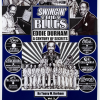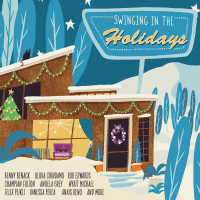Home » Jazz Musicians » Freddie Green
Freddie Green
Freddie Green was the guitarist in what is generally considered to be the best rhythm section in the history of big band jazz, and dubbed the All-American Rhythm Section, which featured Count Basie, bassist Walter Page, and drummer Jo Jones. Green continued with the band until 1987. From the start Green earned a reputation as a stylist without equal, fans and fellow players referred to him as Mr. Rhythm with the utmost respect. Born in Charleston, South Carolina, on March 31, 1911, he began playing banjo at the age of 12. He got his first job locally with a band called the Nighthawks, then toured with the famous Jenkins Orphanage band, though Green himself was not a member of the school. By 1930, he was living in New York, by playing for dancers with stride men like Willie Gant, his unique abilities to judge tempo and create a supple rhythm were forged. It was in late 1936 that John Hammond, then putting together Basie's first tour out of Kansas City, heard Green at the Black Cat and brought him to Roseland to audition for the Count. Although Basie liked his current guitarist, Claude Williams, he let him go in favor of Green, who joined the band after the Roseland engagement. Green cut his first sides with Count Basie and his Orchestra, featuring Walter Page, and Jo Jones, for Decca on March 26, 1937, playing rhythm on "Honeysuckle Rose", "Pennies From Heaven", "Swinging At The Daisy Chain", and "Roseland Shuffle". From March 1937, and excepting a short hiatus after Basie's disbandment in 1950, he and Freddie were inseparable, and the jazz world gained immeasurably from their playing. In Green's case, there were three aspects to what might at first sight seem a simple matter. He freed the beat from metronomic clomping by creating a constantly-shifting variation on the chord structure. He afforded his playing quite subtle variations in dynamics by slight changes in string striking position. He blended his playing very carefully with the drummer. Unlike the majority of his peers, Green did not leave a mighty legacy of solo work, nor even a long list of sessions under his own name. His first, for the Duke label in 1945 with Buck Clayton, Dicky Wells, and Lucky Thompson, remains unissued; his second, for RCA in 1955, “Mr. Rhythm,” has been reissued on CD, as has a 1975 date for Concord Records, which above all these, clearly demonstrated his powerful rhythmic gifts.
Read moreTags
Paul Quinichette: Like Basie

by C. Andrew Hovan
Like any business concerned with making a profit, the record industry has often resorted to questionable concepts, tributes, or other hooks to lure more costumers to their product. Currently we find ourselves in an era where the quality of original music is arguably on the decline, thus it has become even more prevalent to use nostalgia as a selling point. While ghost bands and one-off tributes may be a way to bring a new audience to the music of some ...
Continue ReadingPaul Quinichette & His Basie-ites: Like Basie

by Nic Jones
Like Basie has already seen the light of day in the CD era as an OJC release, but given its qualities, its reappearance here is welcome anyway. Paul Quinichette's career was perhaps more dogged than aided by the lazy “Vice-Pres" tag that was placed upon him because of his stylistic allegiance to Lester Young. As ever the details of the matter were somewhat different. His work was in fact rhythmically far less oblique, whilst the timbre of his playing was ...
Continue ReadingBackgrounder: Freddie Green's Mr. Rhythm

Source:
JazzWax by Marc Myers
Freddie Green, Count Basie's long-time rhythm guitarist, recorded just one album as a leader—Mr. Rhythm, for RCA in December 1955. Green's tenure with Basie date back to March 1937. On Mr. Rhythm, Green assembled an all-star group that was arranged like a pocket version of Basie's band, complete with Nat Pierce on piano: Joe Newman (tp), Henry Coker (tb), Al Cohn (ts-3,cl,bass-cl-1,arr), Nat Pierce (p), Freddie Green (g), Milt Hinton (b), Jo Jones (d), Osie Johnson (d-2) replaces Jones, and ...
read more
Jazz Musician of the Day: Freddie Green

Source:
Michael Ricci
All About Jazz is celebrating Freddie Green's birthday today!
JAZZ MUSICIAN OF THE DAY Freddie Green
Freddie Green - guitar (1911 - 1987) Freddie Green was the guitarist in what is generally considered to be the best rhythm section in the history of big band jazz, and dubbed the All-American Rhythm Section, which featured Count Basie... more
Website | Photos | Articles
Follow Freddie Green
Put AAJ's Musician of the ...
read more
Jazz Musician of the Day: Freddie Green

Source:
Michael Ricci
All About Jazz is celebrating Freddie Green's birthday today!
JAZZ MUSICIAN OF THE DAY Freddie Green
Freddie Green - guitar (1911 - 1987) Freddie Green was the guitarist in what is generally considered to be the best rhythm section in the history of big band jazz, and dubbed the All-American Rhythm Section, which featured Count Basie... more
Website | Videos | Articles
Follow Freddie Green @ AAJ
Put AAJ's Musician ...
read more
Ralph Gleason: "Would it suit your temperament to sit there like Freddie Green and not take solos?" Wes Montgomery: "It would be alright, but I don't know that many chords. I'd be loaded if I knew that many. I'd probably go join a (big) band and play rhythm, man, because he's (Freddie) not just playing chords, he's playing a LOT of chords." Tenor saxophonist Paul Quinichette, who worked with Basie in the 1950's, said, "I think Basie would be lost without Freddie. If you put the tempo too fast, Freddie kept it down there, always controlled. He's got it right there, in his wrist







































